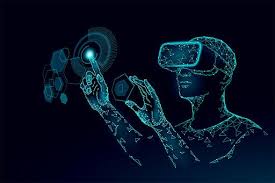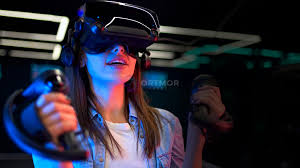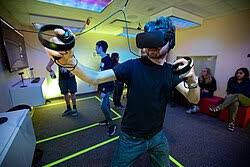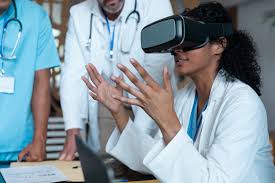WPL Auction 2026 : The Ultimate Guide to Women’s Premier League’s Big Day
Beyond Gaming : How Virtual Reality Is Reshaping Our World

Virtual Reality
From being a specialised idea in science fiction, virtual reality (VR) has developed into a game-changing technology that is changing entire industries and how people live their lives. VR is no longer just for gaming thanks to ongoing improvements in processing power, graphics, and immersive technologies. Today, it is an effective tool in many different fields, such as real estate, tourism, healthcare, and education. This article examines the emergence of virtual reality, its primary uses, and the enormous potential it holds for the future.

Virtual reality: what is it?
The term “virtual reality” describes a simulated environment that may resemble the real world or be entirely different from it. With the use of specialised equipment like motion trackers, gloves, and VR headsets, it immerses users in a completely digital world. Virtual reality (VR) creates a completely different, interactive space, in contrast to augmented reality (AR), which superimposes digital elements onto the real world.
In order to create a sense of “presence”—the psychological state of feeling physically present in a non-physical world—modern VR systems frequently incorporate high-definition visuals, spatial audio, and responsive environments that respond to user movements.
The VR Market’s Growth
Thanks to innovations from tech giants like Microsoft, HTC, Sony, and Meta (formerly Facebook), the global VR market has grown rapidly. Industry projections indicate that by 2030, the VR market will have grown to over $100 billion, with both consumer and business applications expected to make substantial contributions.
Declining hardware costs, increased accessibility, the widespread adoption of 5G, and a burgeoning VR content developer and creator ecosystem are some of the major factors driving this growth.

Virtual Reality Applications
-
Entertainment and Gaming
The first sector to fully adopt VR was gaming. Players can engage with virtual worlds in real time through immersive experiences provided by platforms such as Oculus Quest, PlayStation VR, and HTC Vive. VR is revolutionising live entertainment in addition to traditional gaming; immersive storytelling, interactive films, and virtual concerts are all growing in popularity.
-
Instruction and Practice
With its immersive learning environments, virtual reality is transforming education. From the classroom, students can investigate historical sites, learn about the human body, or carry out challenging scientific investigations. VR offers risk-free simulations for skill development in vocational training. For instance, medical students practise surgeries in virtual labs, and pilots train in flight using VR simulators.
-
Medical Care
VR is being used in healthcare for training as well as treatment. Through exposure therapy, therapists use virtual reality (VR) to treat anxiety disorders, PTSD, and phobias. VR games are used in physical rehabilitation programs to encourage patients and monitor their progress. Additionally, VR improves accuracy and results by helping surgeons plan intricate procedures using 3D organ models.

-
Architecture and Real Estate
With VR, prospective purchasers can virtually tour homes without ever setting foot on them. Before a building is constructed, clients can experience its layout, lighting, and atmosphere thanks to the use of virtual reality (VR) by architects and designers to visualise structures in three dimensions. This decreases expensive design modifications and improves teamwork.
-
Virtual workspaces and remote collaboration
VR is becoming a popular tool for virtual collaboration as remote work becomes more prevalent. Users can interact as avatars, share content, and replicate an actual office setting in 3D meeting spaces created by platforms such as Spatial and Horizon Workrooms. By improving presence and engagement, these immersive workspaces seek to get around the drawbacks of video conferencing.
-
Travel and Cultural Encounters
People can visit museums, cultural sites, and landmarks around the world from the comfort of their own homes with virtual tourism. These experiences, such as a guided tour of Machu Picchu or a virtual reality walk through the Louvre, are democratising access to travel and culture.
Prospects and Difficulties
Prospects: Novel Business Structures: Virtual reality creates opportunities for immersive advertising, subscription-based services, and virtual products.
Job Creation: As the VR ecosystem expands, there will be a greater need for developers, hardware engineers, UX designers, and content producers.
Enhanced Accessibility: By assisting in the removal of geographical and physical barriers, virtual reality can promote inclusivity in healthcare, education, and cultural experiences.

Prospects and Difficulties
- Prospects: Novel Business Structures: Virtual reality creates opportunities for immersive advertising, subscription-based services, and virtual products.
- Job Creation: As the VR ecosystem expands, there will be a greater need for developers, hardware engineers, UX designers, and content producers.
- Enhanced Accessibility: By assisting in the removal of geographical and physical barriers, virtual reality can promote inclusivity in healthcare, education, and cultural experiences.
Challenges
- Hardware Costs: Many consumers still cannot afford high-quality VR systems, even with declining prices.
- Motion Sickness: Motion lag or low visual quality can cause discomfort for certain users.
- Content Development: The need for specific knowledge and equipment to produce engaging virtual reality content may be a deterrent for newcomers.
- Privacy and Ethics: Issues regarding user privacy and ethical use become crucial as virtual reality gathers sensitive biometric and behavioural data.
Also Read This: 6 Dangerous Cybercrime Tactics You’re Not Ready For
VR’s Future
VR is anticipated to become more smooth, wireless, and socially integrated as technology advances. The distinction between the real and virtual worlds may become even more hazy in the future thanks to innovations like brain-computer interfaces, haptic feedback suits, and AI-generated environments.
Virtual reality has the potential to become as commonplace as smartphones in the coming ten years, radically altering the ways in which we connect, learn, work, and play.


